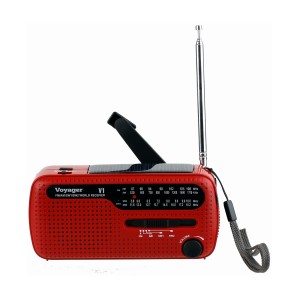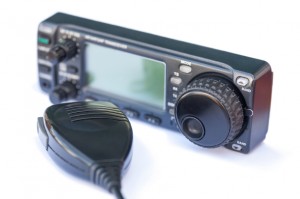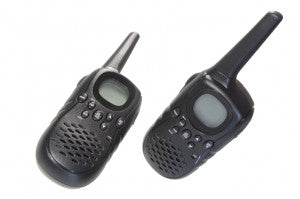
During 9/11, I couldn’t call my parents for three days. I was at college in the Western US, but they were living thirty miles from Manhattan, and their region’s phone lines were all down or busy. It was a sobering reminder at a precarious time of how dependent I am on networks I cannot control.
I’m sorry for starting this post with a reminder of something so sad (I know, 9/11!), but the reality is that when emergencies arise, we suddenly become aware of what we had forgotten or overlooked. And things that we took for granted—like being able to call family or turn on the cable news—may suddenly be gone.
Fortunately, we can have back-ups. Even if we live our day-to-day lives on the communication grid, having emergency devices, like radios, can prevent us from being out of touch from family, news, or help in the moments we need to communicate the most.
Emergency radios allow you to hear broadcast news during an emergency when you don’t have ready access to a working phone, computer, TV, or other grid-related digital device. Some emergency radios, such as the Kaito Voyager V1 Dynamo and Solar Radio, can be powered by hand cranking (where you manipulate a little arm to wind up the radio), solar power (requiring only the sun—no elbow grease!), or using three AAA batteries. Radios that can be powered without output electricity can go a long way in an emergency when the power goes out.

As a plus, the Kaito Voyager Dynamo allows you to charge some cellphones and other USB-charging devices, giving you another way to communicate with loved ones and authorities, as well as giving you up-to-date information in an emergency.
Many emergency radios also have shortwave capabilities. Shortwave radios remain the only way to hear broadcast news without relying upon a satellite or cable service. This makes them incredibly valuable during a large-scale emergency that might affect your ability to access regional services, including traditional AM/FM radio stations.
Ham radios, also known as amateur radios, are the most reliable way to personally communicate with people outside your immediate area. Ham radios can be operated from anywhere you can bring the equipment, and they can be very powerful, enabling you to communicate with other ham radio operators locally, nationally, or even around the world. To operate a ham radio, you need to obtain a license, but local clubs can help you learn what equipment to procure, how to operate that equipment, and how to join the active licensed ham radio operators community. For more information on amateur radio and how to get started, check out our Insight Article, “
Getting Your Ham Radio License.”

Two-way radios are what we often refer to as “walkie-talkies.” Two-way radios are a good choice for emergency communications because they are cheaper and require less know-how than ham radios. Unfortunately, they are also much less powerful than ham radios, and they operate on fewer frequencies (allowing more possibility for interference from other people trying to communicate on the same frequencies). It’s important to know that two-way radio manufacturers often exaggerate the broadcasting frequency of their devices; even if they claim to be able to transmit to a much wider distance, most walkie-talkies have reliable ranges of less than one mile.

During an emergency, the adage that “no news is good news” is flipped on its head. When so much is unsettled or is going awry, every piece of news is good news. If we have these kinds of radios on hand, we can stay in touch and be informed, no matter what else is going on. That sounds like good news to me.
Have you had an experience like mine, when you were suddenly unable to communicate with someone you love or needed to talk to? Please feel free to share your experiences with communication-related emergencies in the comments below. We’d love to hear your stories!
--Sarah B.
Sources:
FAQs about Shortwave Radio, National Association of Shortwave Broadcasters, at http://www.shortwave.org/faq.htm.
Website of The American Radio Relay League, at
http://www.arrl.org/what-is-ham-radio
"Family Radio Service," Federal Communications Commission Encyclopedia, available at
http://www.fcc.gov/encyclopedia/family-radio-service-frs
"Family Radio Service," Wikipedia, at
http://en.m.wikipedia.org/wiki/Family_Radio_Service








8 comments
myron smith
My father owned and used an emergency radio. After him, I put the radio in the store room without knowing the importance of it. Thanks for waking me with the importance of radios. Now I am gonna use it. But I have doubt too… Do we need a license to own an emergency radio?
Maxine
Hi. I have a pair of these radios and I am trying to get a PTT to work with them with no luck at all. The system I am using is an eBay special, military style headset with the oversized 4 way plug and a PTT button with a 2.5m plug for the radio end. The speaker works fine but the PTT either doesn’t work at all or will activate the mic for a second and then it shuts off. Any tips would be appreciated, I am having a real hard time finding anything useful (read very ammature level) for this.
Concerned Citizen
The wind-up radios are an absolute must to have for emergency planning. I have two of them and keep them fully charged on wall chargers. They have come in handy more than once because of power failures in big storms.
I also agree with the importance of Ham Radios. It’s very easy to get a basic (Tech) ham license. Free practice tests are online and have all of the actual FCC test questions and answers.
I got the Tech license and bought a very cheap HT (Hand-held Transceiver) which are ham walkie-talkies.
There are a number of repeaters in my area and I can talk to hams over a very large multi-county area with just a small battery operated HT. Very valuable capability for emergencies!
So at least get a couple of wind-up radios, but things like ham radios and even scanners are also extremely useful.
Stay safe folks!
Jim
Ah, ten roger dee don’t forget CB. Citizens Band radio. Lotta folks specially truckers still use the 11 meter band. Base, mobile, and handheld (walkie talkie) . I still have a vintage crystal controlled Lafayette transceiver from waaaay back in the day.
Hawk
Another thought for your family group is the CB radio, they can go as far as 100 miles. Each family member would need one mounted in their car or have a portable CB to just plug in as needed in an emergency. Some training and coordination on frequency would be needed.
Linda Sand
The other type of radio I recommend is a weather alert radio. This can tell you if you are in the path of an oncoming storm so you know if you need to take shelter. This is especially important when camping as you a re more vulnerable then.
beprepared
Bruce,
Wow! This really does illustrate the importance of Ham radios in an emergency and why we should all consider getting a ham radio license. Thanks for sharing these experiences. Have you read our recent article, “Getting your Ham Radio License?” If not, please check it out here: http://beprepared.com/insight/15176/getting-your-ham-radio-license/ We’d love to hear about more of your comments and experiences getting a ham radio license and using your ham radio.
-Angela
Bruce A. Forster
I have had two major experiences using Ham radio to help others. The first one was the Cholera outbreak in Peru in 1992. A Ham in Texas was talking with a Ham in Peru, trying to coordinate the delivery of emergency medical supplies. As I was listening, atmospheric conditions began to change. The two stations could no longer hear each other, but from my position in Oregon, I still heard both of them. I provided relay services for both of the other operators, passed the information that was needed, and was able to contact a national relief agency by phone to inform them of the situation. The agency I called responded immediately and expedited the delivery of the supplies. I was informed later that my direct involvement saved more than 2500 lives. There are NO WORDS to describe how that feels!
My second experience with Ham Radio was the Oklahoma City Bombing. Landline phones were overloaded and cell phones were virtually USELESS. Again, Ham Radio came to the rescue. A Ham in Oklahoma City was in touch with a Ham in Denver. There mission was to pass Health and Welfare messages between family members who were unable to communicate with each other due to this emergency. I contacted the station in Denver and took names and phone numbers of people on the West Coast who’s loved ones were trying to contact them from the Midwest. I personally passed more than 30 messages to families up and down the West Coast, at my own expense, to let them know their loved ones were okay.
These are but two examples of what a decent Ham radio station is capable of, and as Hams, this is what we DO!